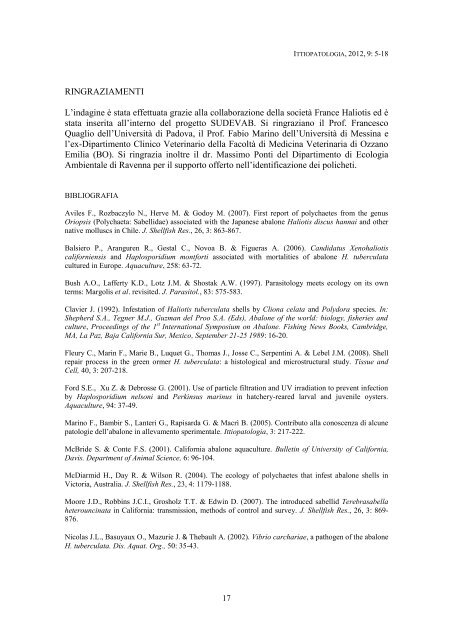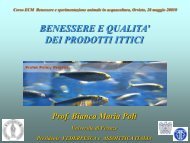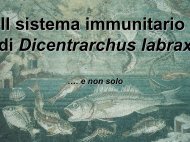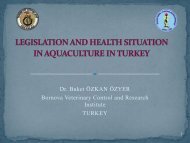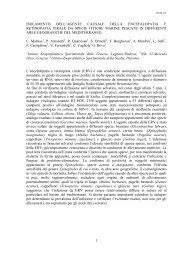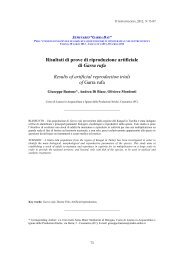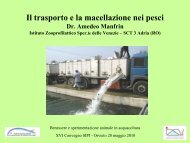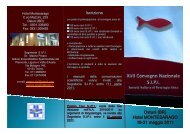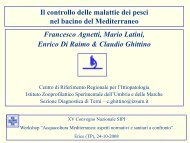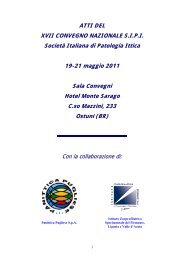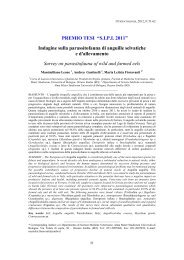ITTIOPATOLOGIA, 2012, 9: 5-18Le ra<strong>di</strong>ografie hanno inoltre permesso <strong>di</strong> osservare come il porifero Cliona sp. non sia unproblema da sottovalutare. Nonostante le lesioni siano poco visibili dall’esterno, il poriferoperforante si sviluppa nello spessore della conchiglia, rendendola fragile. Si nota inoltre comegli abaloni colpiti da Cliona sp. o ricoperti da cirripe<strong>di</strong> presentino infestazioni da polichetimolto più blande, fatto che potrebbe essere spiegabile da meccanismi <strong>di</strong> competizione per lospazio.I risultati ottenuti hanno <strong>di</strong>mostrato come la tipologia <strong>di</strong> allevamento influenzifortemente l’intensità d’infestazione da policheti perforanti: molto bassa nel caso degliallevamenti a terra, dove l’acqua è filtrata ed il fondo delle vasche accuratamente pulito,maggiore in maricoltura, ma con valori più elevati in policoltura, compromettendo lacrescita degli abaloni.Le sacche della policoltura, formate da una rete a maglie strette, si riempionovelocemente <strong>di</strong> detriti impedendo una buona circolazione dell’acqua e sono <strong>di</strong>spostemolto vicine al fondale, in una zona a bassa profon<strong>di</strong>tà con scarso flusso idro<strong>di</strong>namico.In effetti, le gabbie della maricoltura permettono un migliore ricambio idrico e sono<strong>di</strong>sposte in una zona <strong>di</strong> corrente dove il fondale sabbioso è privo <strong>di</strong> detriti.Dagli ultimi stu<strong>di</strong> <strong>di</strong> Sato-Okoshi et al. (2008) risulta che quando il giovane policheteesce nell’ambiente esterno possiede già i due palpi alimentari e cinque segmenti.Sembra capace <strong>di</strong> nuotare solo per un breve periodo e si fissa quin<strong>di</strong> al supporto piùvicino che incontra. Considerando questo comportamento, sembra ovvio che un riciclodell’acqua limitato, un basso profilo idro<strong>di</strong>namico, la vicinanza del fondale el’accumulo <strong>di</strong> se<strong>di</strong>menti e materiale organico possano favorire la parassitosi dapolicheti. Non si sa molto invece della riproduzione e del ciclo larvale dei sabelli<strong>di</strong>perforanti.L’identificazione tassonomica dei policheti campionati su base morfologica risulta inlinea con lavori precedenti (Clavier, 1992), che hanno descritto nell’abalone spioni<strong>di</strong>appartenenti al genere Polydora/Boccar<strong>di</strong>a.Durante la nostra indagine sono stati rinvenuti inoltre alcuni sabelli<strong>di</strong> perforanti. Nessunappartenente a questa famiglia era stato fino ad ora descritto in abaloni nel continente europeoe gli esemplari rinvenuti appaiono morfologicamente <strong>di</strong>versi dalle specie descritte in H. <strong>di</strong>scushannai (Aviles et al., 2007) ed in H. rufescens (Moore, 2007).La prevalenza e l’intensità <strong>di</strong> infestazione dei policheti sabelli<strong>di</strong> si sono attestati intornoa valori molto bassi, ma da un punto <strong>di</strong> vista sanitario questa problematica è da tenere indebita considerazione in quanto la presenza <strong>di</strong> un singolo in<strong>di</strong>viduo può provocarelesioni molto più importanti rispetto a quelle causate dagli spioni<strong>di</strong> anche perché gliin<strong>di</strong>vidui possono raggiungere, secondo osservazioni effettuate su un soggetto selvatico,<strong>di</strong>mensioni ragguardevoli (>4 cm). L’assenza <strong>di</strong> sabelli<strong>di</strong> nelle ostriche campionate fapresupporre che la parassitosi osservata negli abaloni in policoltura non sia correlabilealla convivenza con le ostriche, ma bensì alla tecnica e/o al sito <strong>di</strong> allevamento.Poiché le tecniche <strong>di</strong> allevamento a terra sembrano influenzare negativamente leproprietà organolettiche dell’abalone, la maricoltura in gabbia potrebbe rappresentare unidoneo sistema <strong>di</strong> produzione alternativo, ma in tal caso i problemi sanitari causati daipolicheti perforanti andranno tenuti in opportuna considerazione.16
ITTIOPATOLOGIA, 2012, 9: 5-18RINGRAZIAMENTIL’indagine è stata effettuata grazie alla collaborazione della società France <strong>Haliotis</strong> ed èstata inserita all’interno del progetto SUDEVAB. Si ringraziano il Prof. FrancescoQuaglio dell’Università <strong>di</strong> Padova, il Prof. Fabio Marino dell’Università <strong>di</strong> Messina el’ex-Dipartimento Clinico Veterinario della Facoltà <strong>di</strong> Me<strong>di</strong>cina Veterinaria <strong>di</strong> OzzanoEmilia (BO). Si ringrazia inoltre il dr. Massimo Ponti del Dipartimento <strong>di</strong> EcologiaAmbientale <strong>di</strong> Ravenna per il supporto offerto nell’identificazione dei policheti.BIBLIOGRAFIAAviles F., Rozbaczylo N., Herve M. & Godoy M. (2007). First report of polychaetes from the genusOriopsis (Polychaeta: Sabellidae) associated with the Japanese abalone <strong>Haliotis</strong> <strong>di</strong>scus hannai and othernative molluscs in Chile. J. Shellfish Res., 26, 3: 863-867.Balsiero P., Aranguren R., Gestal C., Novoa B. & Figueras A. (2006). Can<strong>di</strong>datus Xenohaliotiscaliforniensis and Haplospori<strong>di</strong>um montforti associated with mortalities of abalone H. <strong>tuberculata</strong>cultured in Europe. Aquaculture, 258: 63-72.Bush A.O., Lafferty K.D., Lotz J.M. & Shostak A.W. (1997). Parasitology meets ecology on its ownterms: Margolis et al. revisited. J. Parasitol., 83: 575-583.Clavier J. (1992). Infestation of <strong>Haliotis</strong> <strong>tuberculata</strong> shells by Cliona celata and Polydora species. In:Shepherd S.A., Tegner M.J., Guzman del Proo S.A. (Eds), Abalone of the world: biology, fisheries andculture, Procee<strong>di</strong>ngs of the 1 st International Symposium on Abalone. Fishing News Books, Cambridge,MA, La Paz, Baja California Sur, Mexico, September 21-25 1989: 16-20.Fleury C., Marin F., Marie B., Luquet G., Thomas J., Josse C., Serpentini A. & Lebel J.M. (2008). Shellrepair process in the green ormer H. <strong>tuberculata</strong>: a histological and microstructural study. Tissue andCell, 40, 3: 207-218.Ford S.E., Xu Z. & Debrosse G. (2001). Use of particle filtration and UV irra<strong>di</strong>ation to prevent infectionby Haplospori<strong>di</strong>um nelsoni and Perkinsus marinus in hatchery-reared larval and juvenile oysters.Aquaculture, 94: 37-49.Marino F., Bambir S., Lanteri G., Rapisarda G. & Macrì B. (2005). Contributo alla conoscenza <strong>di</strong> alcunepatologie dell’abalone in allevamento sperimentale. Ittiopatologia, 3: 217-222.McBride S. & Conte F.S. (2001). California abalone aquaculture. Bulletin of University of California,Davis. Department of Animal Science, 6: 96-104.McDiarmid H., Day R. & Wilson R. (2004). The ecology of polychaetes that infest abalone shells inVictoria, Australia. J. Shellfish Res., 23, 4: 1179-1188.Moore J.D., Robbins J.C.I., Grosholz T.T. & Edwin D. (2007). The introduced sabellid Terebrasabellaheterouncinata in California: transmission, methods of control and survey. J. Shellfish Res., 26, 3: 869-876.Nicolas J.L., Basuyaux O., Mazurie J. & Thebault A. (2002). Vibrio carchariae, a pathogen of the abaloneH. <strong>tuberculata</strong>. Dis. Aquat. Org., 50: 35-43.17
- Page 1: ITTIOPATOLOGIA, 2012, 9: 5-18PREMIO
- Page 4 and 5: ITTIOPATOLOGIA, 2012, 9: 5-18specie
- Page 6 and 7: ITTIOPATOLOGIA, 2012, 9: 5-18RISULT
- Page 8 and 9: ITTIOPATOLOGIA, 2012, 9: 5-18Grafic
- Page 10 and 11: ITTIOPATOLOGIA, 2012, 9: 5-18dr. Ma
- Page 14: ITTIOPATOLOGIA, 2012, 9: 5-18Sato-O


